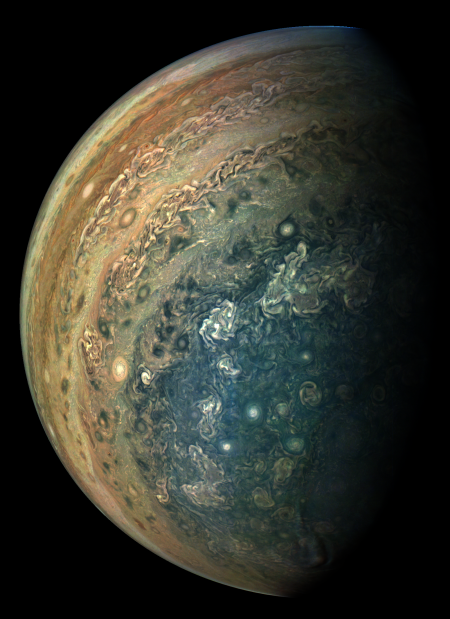First images released from Juno’s seventh close fly-by of Jupiter

Cool image time! The raw images taken during Juno’s seventh close fly-by of Jupiter have been released. The image on the right, reduced in resolution to post here, was reprocessed by Gerald Eichstädt and shows the gas giant’s south polar region.
It is worthwhile comparing this with previous south pole images, as well as other images from this fly-by reprocessed by Eichstadt. I want to know whether anyone can identify specific storms and show how they have changed over time. Unfortunately, Juno’s orbit is large, and so it only drops in close every 53 days, allowing for these storms to change a great deal, and thus making it more difficult to link images of the same changing storm. Moreover, the images don’t necessarily show the same longitudes on Jupiter, making this even more difficult.
Nonetheless, to gain a real understanding of Jupiter’s atmosphere will require a clear understanding of the pace in which its storms and atmosphere change. These images might give us our first glimpse of this process.

Cool image time! The raw images taken during Juno’s seventh close fly-by of Jupiter have been released. The image on the right, reduced in resolution to post here, was reprocessed by Gerald Eichstädt and shows the gas giant’s south polar region.
It is worthwhile comparing this with previous south pole images, as well as other images from this fly-by reprocessed by Eichstadt. I want to know whether anyone can identify specific storms and show how they have changed over time. Unfortunately, Juno’s orbit is large, and so it only drops in close every 53 days, allowing for these storms to change a great deal, and thus making it more difficult to link images of the same changing storm. Moreover, the images don’t necessarily show the same longitudes on Jupiter, making this even more difficult.
Nonetheless, to gain a real understanding of Jupiter’s atmosphere will require a clear understanding of the pace in which its storms and atmosphere change. These images might give us our first glimpse of this process.


